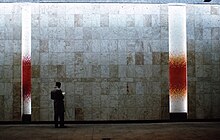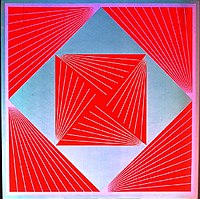Op art

Op art, short for optical art, is a style of visual art that uses optical illusions.[1]
Op artworks are abstract, with many better-known pieces created in black and white. Typically, they give the viewer the impression of movement, hidden images, flashing and vibrating patterns, or swelling or warping.
History




Op art perhaps more closely derives from the constructivist practices of the Bauhaus.[7] This German school, founded by Walter Gropius, stressed the relationship of form and function within a framework of analysis and rationality. Students learned to focus on the overall design or entire composition to present unified works. Op art also stems from trompe-l'œil and anamorphosis. Links with psychological research have also been made, particularly with Gestalt theory and psychophysiology.[2] When the Bauhaus was forced to close in 1933, many of its instructors fled to the United States. There, the movement took root in Chicago and eventually at the Black Mountain College in Asheville, North Carolina, where Anni and Josef Albers eventually taught.[8]
Op artists thus managed to exploit various phenomena," writes Popper, "the after-image and consecutive movement; line interference; the effect of dazzle; ambiguous figures and reversible perspective; successive colour contrasts and chromatic vibration; and in three-dimensional works different viewpoints and the superimposition of elements in space.[2]
In 1955, for the exhibition Mouvements at the
Some members of the group Nouvelle tendance (1961–1965) in Europe also were engaged in op art as Almir Mavignier and Gerhard von Graevenitz, mainly with their serigraphics. They studied optical illusions. The term op irritated many of the artists labeled under it, specifically including Albers and Stanczak. They had discussed upon the birth of the term a better label, namely perceptual art.[9] From 1964, Arnold Schmidt (Arnold Alfred Schmidt) had several solo exhibitions of his large, black and white shaped optical paintings exhibited at the Terrain Gallery in New York.[10]
The Responsive Eye
In 1965, between February 23 and April 25, an exhibition called The Responsive Eye, created by William C. Seitz, was held at the Museum of Modern Art in New York City and toured to St. Louis, Seattle, Pasadena, and Baltimore.[11][12] The works shown were wide-ranging, encompassing the minimalism of Frank Stella and Ellsworth Kelly, the smooth plasticity of Alexander Liberman, the collaborative efforts of the Anonima group, alongside the well-known Wojciech Fangor, Victor Vasarely, Julian Stanczak, Richard Anuszkiewicz, Wen-Ying Tsai, Bridget Riley and Getulio Alviani. The exhibition focused on the perceptual aspects of art, which result both from the illusion of movement and the interaction of color relationships.
The exhibition was a success with the public (visitor attendance was over 180,000),
Method of operation
Black-and-white and the figure-ground relationship
Op art is a perceptual experience related to how vision functions. It is a dynamic visual art that stems from a discordant
Color
Beginning in 1965
-
Victor Vasarely, Kezdi-Ga, 1970, Serigraph, Edition of 250, 20 × 20 in
-
Intrinsic Harmony, by Richard Anuszkiewicz, 1965
Similarities with other art styles
Although op art is a unique style, it has similarities with styles such as
Exhibitions
- L'Œil moteur: Art optique et cinétique 1960–1975, Musée d'art moderne et contemporain, Strasbourg, France, May 13–September 25, 2005.
- Op Art, Schirn Kunsthalle, Frankfurt, Germany, February 17–May 20, 2007.
- The Optical Edge, The Pratt Institute of Art, New York, March 8–April 14, 2007.
- Optic Nerve: Perceptual Art of the 1960s, Columbus Museum of Art, Columbus, Ohio, February 16–June 17, 2007.
- CLE OP: Cleveland Op Art Pioneers, Cleveland Museum of Art, Cleveland, Ohio, April 9, 2011 – February 26, 2012
- Bridget Riley has had several international exhibitions (e.g. Dia Center, New York, 2000; Tate Britain, London, 2003; Museum of Contemporary Art, Sydney, 2004).
See also
- List of op artists
- Divisionism
- Kinetic art
- Binakael (similar patterns in traditional Filipino textiles)
- Chubb illusion
- Cornsweet illusion
- Impossible object
- Lilac chaser
- M. C. Escher
- Mach bands
- Multistable perception
- Optical illusion
- Pattern glare
- Perception
- Peripheral drift illusion
- Same color illusion
- Trompe-l'œil
- Zero (art)
References
- ISBN 978-1-55859-127-1
- ^ a b c "The Collection - MoMA". The Museum of Modern Art. Retrieved November 5, 2017.
- ^ Lee, Alan. "Seurat and Science." Art History 10 (June 1987): 203-24.
- ^ Jon Borgzinner. "Op Art", Time, October 23, 1964.
- ^ "Op-Art: History, Characteristics". www.Visual-Arts-Cork.com. Retrieved November 5, 2017.
- ^ "The Hypnotic, Mind-bending Work of Italian Designer Franco Grignani". Eye on Design. 2019-06-28. Retrieved 2019-12-15.
- ^ "Op-Art: History, Characteristics". www.visual-arts-cork.com. Retrieved 2019-12-15.
- ^ "Black Mountain College Movement Overview". The Art Story. Retrieved 2019-12-15.
- ^ Bertholf. "Julian Stanczak: Decades of Light" Yale Press
- ^ "A Brief History of the Terrain Gallery". TerrainGallery.org. Archived from the original on April 3, 2010. Retrieved November 5, 2017.
- OCLC 644787547. Retrieved January 23, 2016.
- ^ "The Responsive Eye" (PDF) (Press release). New York: Museum of Modern Art. February 25, 1965. Retrieved January 23, 2016.
- ^ Gordon Hyatt (writer and producer), Mike Wallace (presenter) (1965). The Responsive Eye (Television production). Columbia Broadcasting System, Inc. Archived from the original on 2013-01-03. (Available on YouTube in three sections.)
- ^ "MoMA 1965: The Responsive Eye". CoolHunting.com. Archived from the original on September 28, 2009. Retrieved November 5, 2017.
- ^ Brian De Palma (director) (1966). The Responsive Eye (Motion picture).
- ISBN 9780192842343. Retrieved November 5, 2017 – via Google Books.
- ^ See Color Function Painting: The Art of Josef Albers, Julian Stanczak, and Richard Anuszkiewicz, Wake Forest University, reprinted 2002.
Bibliography
- Frank Popper, Origins and Development of Kinetic Art, New York Graphic Society/Studio Vista, 1968
- Frank Popper, From Technological to Virtual Art, Leonardo Books, MIT Press, 2007
- Seitz, William C. (1965). The Responsive Eye (PDF). New York: Museum of Modern Art. Exhibition catalog.
{{cite book}}: CS1 maint: postscript (link)




